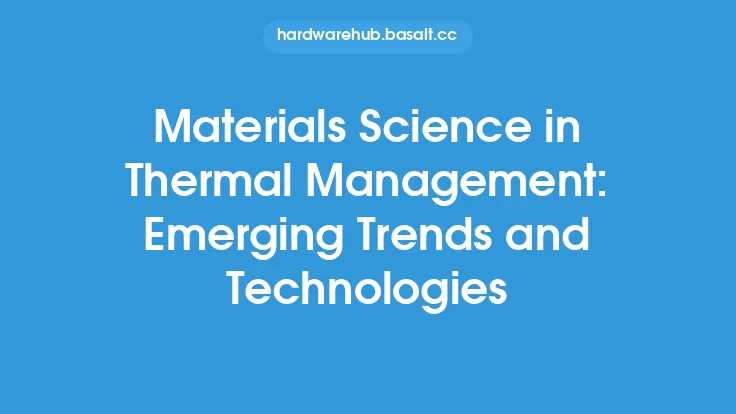Thermal management is a critical aspect of maintaining the reliability and performance of electronic systems, as excessive heat can lead to premature failure, reduced lifespan, and decreased efficiency. As the density of electronic components increases, the challenge of managing heat becomes even more significant. In this article, we will explore various thermal management techniques that can be employed to reduce heat-related failures in electronic systems.
Introduction to Thermal Management Techniques
Thermal management techniques are designed to control the temperature of electronic components, ensuring that they operate within a safe and optimal range. These techniques can be broadly categorized into two main groups: passive and active. Passive techniques rely on the natural conduction and convection of heat, while active techniques utilize external devices or systems to enhance heat transfer. Some common passive techniques include the use of heat sinks, thermal interface materials, and thermal vias, while active techniques include the use of fans, blowers, and liquid cooling systems.
Heat Sinks and Thermal Interface Materials
Heat sinks are a common passive thermal management technique used to increase the surface area of a component, allowing for more efficient heat transfer to the surrounding air. They are typically made of a high thermal conductivity material, such as copper or aluminum, and are attached to the component using a thermal interface material (TIM). TIMs are used to fill the microscopic gaps between the component and the heat sink, ensuring maximum contact and heat transfer. The choice of TIM is critical, as it can significantly impact the overall thermal performance of the system. Some common TIMs include thermal tapes, adhesives, and greases.
Active Thermal Management Techniques
Active thermal management techniques are used to enhance heat transfer beyond what is possible with passive techniques. Fans and blowers are commonly used to increase airflow over heat sinks, allowing for more efficient convective heat transfer. Liquid cooling systems, on the other hand, use a coolant to absorb heat from the component and transfer it to a remote location, where it can be dissipated. These systems can be highly effective, but require careful design and implementation to ensure reliable operation. Other active techniques include the use of thermoelectric coolers, which use the Peltier effect to transfer heat from one side of a device to the other.
Advanced Thermal Management Techniques
In recent years, several advanced thermal management techniques have emerged, offering improved performance and efficiency. One such technique is the use of nanomaterials, which can be used to create high thermal conductivity interfaces and heat sinks. Another technique is the use of micro-channel heat exchangers, which use tiny channels to increase the surface area of a heat exchanger, allowing for more efficient heat transfer. Phase change materials (PCMs) are also being used to absorb and release heat, allowing for more efficient thermal energy storage and release.
Design Considerations for Thermal Management
When designing a thermal management system, several factors must be considered. The first is the thermal load of the component, which will determine the required heat transfer rate. The next is the available space and weight constraints, which will impact the choice of heat sink, fan, or other thermal management device. The ambient temperature and airflow must also be considered, as these will impact the convective heat transfer coefficient and the overall thermal performance of the system. Finally, the reliability and maintainability of the system must be considered, as these will impact the overall cost and effectiveness of the thermal management solution.
Thermal Management in Emerging Technologies
As emerging technologies such as 5G, artificial intelligence, and the Internet of Things (IoT) continue to evolve, thermal management will play an increasingly critical role. These technologies often require high-performance computing and high-power components, which generate significant amounts of heat. To address this challenge, new thermal management techniques and materials are being developed, such as graphene and other 2D materials, which offer high thermal conductivity and flexibility. Additionally, advanced simulation tools and modeling techniques are being used to optimize thermal management system design and performance.
Conclusion
Thermal management is a critical aspect of electronic system design, and a wide range of techniques are available to reduce heat-related failures. From passive techniques such as heat sinks and thermal interface materials, to active techniques such as fans and liquid cooling systems, the choice of thermal management solution will depend on the specific requirements of the application. As emerging technologies continue to evolve, the importance of thermal management will only continue to grow, driving the development of new materials, techniques, and technologies to address the challenges of heat generation and transfer. By understanding the principles of thermal management and the available techniques, designers and engineers can create reliable, efficient, and high-performance electronic systems that meet the demands of an increasingly complex and interconnected world.





